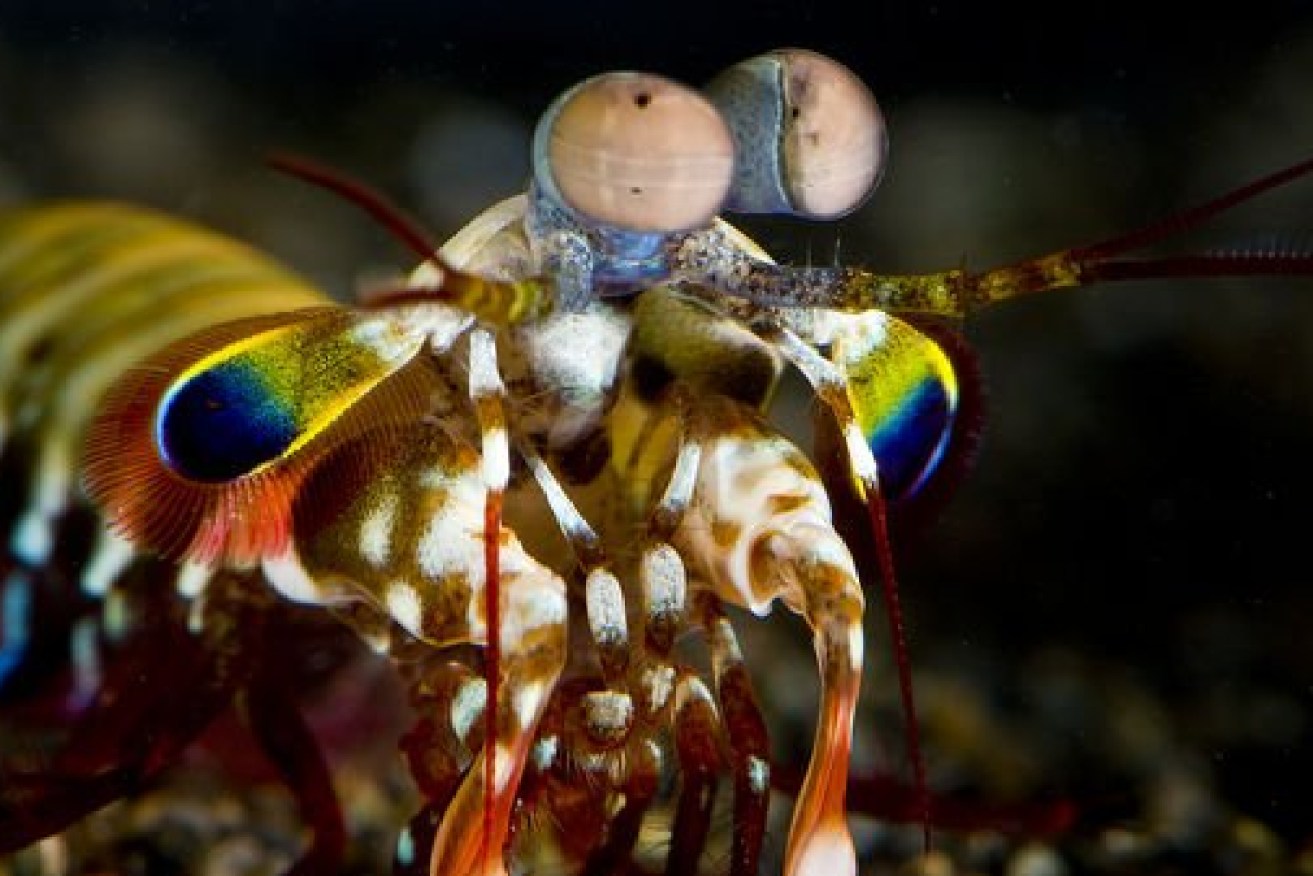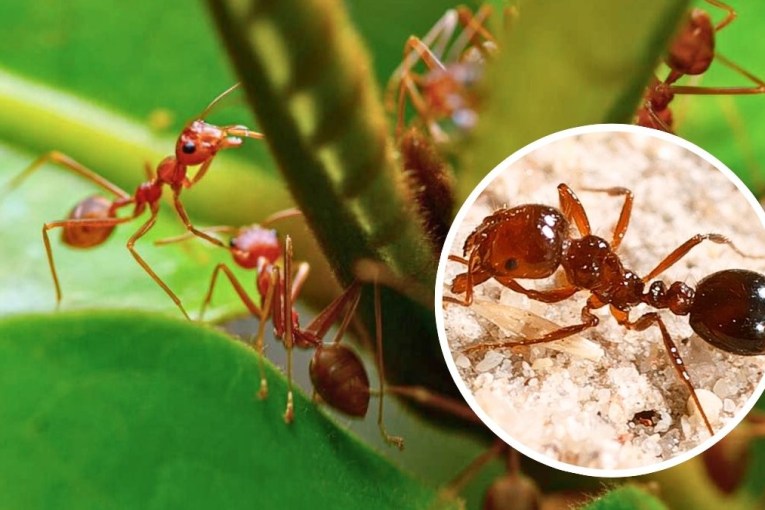Meet some of the players (and spectators) in this year’s massive coral spawning event

Mantis shrimp range in colour from sandy shades to bright blues and reds. Photo: Roy Caldwell
This weekend one of the world’s biggest sex events is happening underwater off the north Queensland coast.
The annual mass coral spawning event, set to happen over three nights from Friday, will see the corals of the Great Barrier Reef release trillions of eggs and sperm into the water.
This year you can catch this incredible natural phenomenon during Reef Live, a two-part live ABC TV event.
But the more than 800 recognised coral species are just the start of the food chain for Australia’s magnificent Great Barrier Reef. It’s home to an abundance of other wildlife – each species playing a critical role in keeping the ecosystem balanced.
Here are seven creatures that you’re likely to come across when you visit the reef.
Acropora millepora

This type of coral comes in a range of colours including a salmon-like pink, yellow and green. Photo: Australian Institute Of Marine Science
Often described as “pillow-shaped” or “fluffy”, Acropora millepora play a vital role in providing other reef creatures with a home.
Australian Institute of Marine Science (AIMS) research scientist Kate Quigley says millepora, one of the most common corals, provide the reef structure and can get to the size of a dinner plate.
“Corals like millepora are so important because they have lots of little nooks and crannies that fish, and different invertebrates can live in,” she says.
The millepora come in an array of colours, including a pinky-orange, green and yellow, and can quickly repopulate after disturbance events like cyclones or mass bleaching.
“They are animals, but they don’t have the kind of classic front end and back end,” Dr Quigley says.
“Corals are really cool because they have little photosynthetic algae that live inside their cells.”
The algae can create complex sugars from sunlight that then feeds the coral. This is why they are found in shallow water.
At night they filter feed from the water.

Acropora millepora exhibiting different colour morphs during a mass coral bleaching event. Photo: ARC Centre Of Excellence For Coral Reef Studies/Gergely Torda
Dr Quigley says it’s unclear just how many individual corals are on the Great Barrier Reef but there’s evidence the mortality rate is high.
“So unlike maybe rhinoceros or whales, it’s actually very hard to count corals because they’re so hard to tell apart.”
She says often corals have different modes of reproduction.
Millepora can reproduce by spawning their eggs and sperm at the same time, but there’s evidence they can create clones.
Despite these various means of reproduction, Dr Quigley says, like many corals, millepora are being pushed to their limits.
While the most significant threat is climate change, and the knock-on impact of coral bleaching, crown-of-thorns predation, cyclone destruction, and declining water quality are also concerns.
“These are animals just like you would see animals on land, but their sensitivity to increasing temperatures is quite extreme and it’s unclear how much more they can be pushed.”
Crown-of-thorns starfish

The crown-of-thorns starfish has poisonous barbs and feasts on coral. Photo: Australian Institute Of Marine Science
“It’s probably one of the best known and most charismatic starfish on the reef,” AIMS principal research scientist Sven Uthicke says about the crown-of-thorns starfish.
These large native starfish, which have poisonous barbs and can get to about 80 centimetres in size, feed on coral.
“There’s a very fine balance between the starfish and the corals,” Dr Uthicke says.
“When there’s too many starfish, the coral suffer and they could aggravate the coral damage which was done by, for example coral bleaching or others things.”
Dr Uthicke describes the creatures’ eating habit as “pretty quirky”.

Dr Sven Uthicke nets a crown-of-thorns starfish. Photo: Australian Institute Of Marine Science
It crawls on top of the coral and inverts its whole stomach inside out over the coral and then digests its food.
While it’s hard to know exact numbers, Dr Uthicke says there would be millions of crown-of-thorns across the reef.
“You can have reefs where you go swimming and you see hundreds and hundreds of them at the same time. If there isn’t an outbreak, they’re very rare and you’d be kind of happy to have found one.”
Dr Uthicke says the starfish have few predators and there are theories that outbreaks could be linked to ocean nutrients caused by coastal and agricultural run-off into the ocean.
He says outbreaks progressively moved along the reef about every 15 years.
“They’re not breaking out over the whole barrier reef at the same time, they start up there [north],” he says.
“And then slowly these outbreaks move further south so practically by the time they’ve reached the southern end of the reef you have a new outbreak starting again up north.”
Green turtle

Green turtles have a mysterious almost 20-year period out at sea. Photo: Nicole Hegarty
Green turtles start their lives as hatchlings scrambling down the beach to reach the water before running a “gauntlet of fish predators”.
“They swim absolutely frantically for the first 24 hours to get away from the shallow nearshore water where the fish density is highest into the deeper, more oceanic waters,” says David Booth, a marine scientist at the University of Queensland.
After that, the next 15 to 20 years are a mystery.
“They are right out to sea in what’s known as the ‘lost years’,” Dr Booth says.
When the turtles are next spotted, they are about 40 cm (or the size of a dinner plate) and go from being planktonic feeders on the surface of the water to bottom grazers eating seagrass and algae in a nearshore environment, where they remain for the next 10-15 years.
Some estimates suggest only one in 1,000 hatchlings survive long enough to breed.
When the opportunity arises they’ll munch on a jellyfish.
By the time the female first breeds, aged around 35 years, she can be about 80 cm in size.
Each season she can lay up to nine clutches of between 80 and 140 eggs.

Green turtle hatchlings are preyed upon by ghost crabs, sharks, rays and other big fish. Photo: WWF/Mel Staines
“Every clutch is fertilised by one, two, three or four males,” Dr Booth says.
She will breed once every four to six years depending on the nutrients available.
Dr Booth says the green turtle, which is listed as threatened, has two genetically distinct populations on the Great Barrier Reef.
While the southern population appears to be increasing after harvesting stopped in the 1950s, it’s a different story further north.
“It also looks like there might be a problem with an overproduction of females,” he says.
“All sea turtles have temperature-dependent sex determination … warming temperatures has led to a predominance of female hatchlings.”
While there are still “plenty of males”, in the not too distant future there maybe not enough males to fertilise all the females and this will affect the population.
Mantis shrimp
These little creatures are thought to have the best eyesight of any animal on the planet.
Reef HQ aquarist Chris Benstead says the eyes of mantis shrimp have about six times as many photoreceptors as the human eye, resulting in good depth perception and excellent vision.
There are hundreds of mantis shrimp species and they range in length from 5 to about 30 cm.

A white and brown mantis shrimp is almost translucent. Photo: Great Barrier Reef Marine Park Authority/K Atkinson
The most common species on the Great Barrier Reef, peacock mantis shrimp, are vibrantly coloured – green, blue and red.
Often the peacock mantis shrimp live around the reef while the lighter coloured species live in burrows in the sand.
“They want to camouflage into their surroundings,” Mr Benstead says.
Mantis shrimp have several distinctive features, some have “caveman-like clubs” while others have spears to catch food.
Those with the clubs quickly “crack open the shells of crabs, little clams and other crustaceans”, while those with spears catch fish.
Mr Benstead says the mantis shrimp keep small molluscs like snails in check on the reef and are a food source for larger fish.
Bumphead parrotfish

A bumphead parrotfish with a distinctive hump on its head and parrot-like beak. Photo: Great Barrier Reef Marine Authority/R. Aiello
Bumphead parrotfish help keep the reef healthy.
These are the largest parrotfish in the world and can reach 1.5 metres in length and weigh more than 40 kilograms.
They use their powerful beak to eat dead coral, graze on rocks and stop algae from suffocating the coral.

Often bumphead parrotfish swim in large schools on the Great Barrier Reef. Photo: Great Barrier Reef Marine Authority/K Hoppen
“It basically enables fresh corals, so new recruits to settle onto that fresh clean rock and actually start another coral colony,” he says.
“When you’re underwater … you can always tell when there’s a big bumphead parrotfish around [because] it’s like a grinding sound.”
The large fish with the distinctive hump on their head are often found in schools and stay on a particular reef to graze throughout the day and find shelter at night.
Mr Benstead says usually there’s a “big dominate male” surrounded by a harem of females.
“You’ll get big congregations of these bumphead parrotfish all coming together to mass spawn and mass reproduce,” he says.
White tip reef shark

White tip reef sharks are nocturnal hunters. Photo: Great Barrier Reed Marine Park Authority/ D. Wachenfeld
At the top of the food change is the white tip reef shark, easily distinguished by the noticeable white tip on top of its dorsal fin and slender shape.
“They are nocturnal hunters,” Mr Benstead says.
“They really try to find sleeping fish and crustaceans in amongst the coral and rocks and having that sort of a flat-screwdriver-almost head enables them to jam their head down into those cracks and crevices to try and extract the food.”

The shark gives birth to live young. Photo: Great Barrier Reef Marine Park Authority/J Harding
They also use electro receptors to hone in on their prey.
“They can also gulp quite large amounts of water, almost creating a vacuum into their mouths and literally inhale their prey.”
During the day they often sleep on top of one another in caves or other safe places.
“They really have a vital role in the ecosystem to keep those fish populations nice and healthy,” Mr Benstead says.
Like lions on an African savannah, sharks target sick, injured and dying animals.
White tip reef sharks average about 1.5 m in size and give birth to live young.
“If they are not fast enough, mum can turn around and make a quick meal of them,” he says.
Eastern reef egret

On Heron Island about 20 per cent of the reef egrets are grey and 80 per cent are white. Photo: ABC Open Contributor Backyardzoology
These long-legged wading birds forage on the reef for food.
Graeme Cumming, from James Cook University, says the egrets, which are grey or white, live on islands along the edge of the reef.
“They forage fish basically, but they’re also known to eat invertebrates like snails. They might eat squid. Just kind of a bit of whatever they can find that’s alive,” Professor Cumming says.
“They’re kind of stand-and-wait predators.”
As the tide falls to expose the reef crust, the birds spend time foraging.
“They’ll stand very still on the top of the reef and wait for prey items to come by and then stab down with their long pointy beak.”
On Heron Island the egrets also eat Black Noddy chicks.
Eastern reef egrets are considered common and widespread, but there’s some evidence that numbers are declining around Australia.
There are about 120 birds on Heron Island.
Professor Cumming says the egrets are one of the birds “most tightly connected to the shallow water reefs”.
Reef Live airs Friday, December 4 at 8:30pm and Sunday, December 6 at 8:40pm on ABC and iview.








